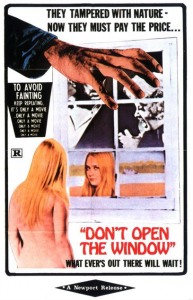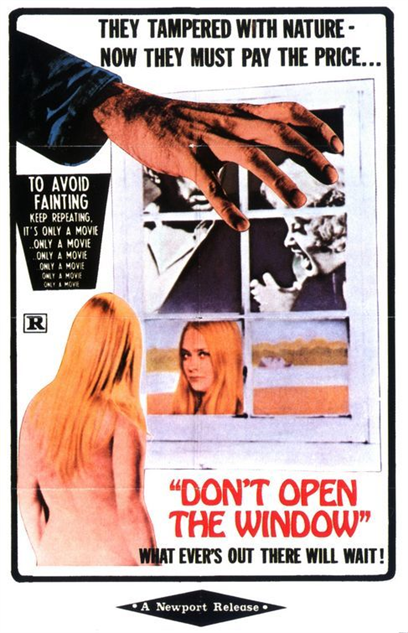
Non si Deve Profanare il Sonno Dei Morti/Let Sleeping Corpses Lie(1974) is a lively Italian/Spanish take on Night of the Living Dead(1968). Yet is not a mere rip off because of own brand of zombie horror. Director, Jorge Grau helps make this film a classic zombie pic on its own terms with atmospheric scenery, remarkable moments of horror, gore highlights, and effective surprise twists. In some ways a much more polish looking film than NOTLD. Acting in film is better than in the average zombie pic. Underrated zombie chiller that has recently gotten the attention it deserves with DVD release.
The first zombie to appear on the scene is Guthrie. The attack on Edna by Guthrie is reminiscent of the attack on Barbara in Night of the Living Dead(1968). Guthrie, the zombie is only on the screen for the first half and the film could have used him for its entirity. Fernando Hilbeck has the perfect face and manner to be a menacing looking zombie. Guthrie is the most imposing zombie figure ever to step foot in a zombie horror picture. Guthrie is in the early stages of zombifcation which is why he doesn’t look like the usual flesh rotting zombie.
Beneath the gore and horror is a fascinating subtext on fascism. Fascism as represented by the inspector is shown to be closed minded and ruthlessly proud. Director, Jorge Grau lived in Spain during the reign of Francisco Franco which plays an influence on the fascist depiction of the Manchester inspector. Relays that fascism is at its most dangerous when hiding behind law and order. Let Sleeping Corpses Lie(1974) was not popular among British censors or Police because of its anti-authority stance. Fascist subtext is dealt with great power and intellegence.
It was Let Sleeping Corpses Lie(1974) and not Dawn of the Dead(1978) that mainly influenced a rash of Italian cannibal/zombie films of the late 70s/early 80s. Lucio Fulci was one such director who was influenced by LSCL that he patterned his gothic zombie pics after the look of this film. DOTD influence is significant on the Italian zombie craze but not as high as people think. The editor and make up effects man for LSCL would become part of Fulci’s entourage. Provides a medium between Night of the Living Dead(1968) & Dawn of the Dead(1978). The Italian zombie films of late 70s/early 80s owe a debt of graditude to this excellent made zombie pic.
Cemetery sequence is first sustained terror moment. Suspenseful scene where the viewer begins feeling the terror felt by George and Edna. Moment when George and Edna attempt to break outside a grave from inside the parlor room inspired a identical moment in House by the Cemetery(1981). Guthrie’s touching of corpses to bring them back is a dark parody of Jesus raising Lazarus from the dead. Some juicy gore effects are provided with the bloody death of a Police officer. Expertly handled by Jorge Grau with a feeling of the macabre.
Although zombies are featured as villains, its the inspector played by Arthur Kennedy that is the true villain of the story. The zombies are not in long or sparse enough to be counted as screen villains. The inspector is a self righteous jerk whose unwilling to admit when he’s wrong. Arthur Kennedy is convincing bitter as the fascist and sadistic Police Inspector. He uses villainous tactics in handling the case described in the film without willing to find out the truth. By shifting the role of villain to Police Inspector, the film becomes an anti-establishment film.
Few interesting ideas pop up during course of story. First, there is idea of dead coming back to life via an agriculture sonic pest killing device which is an provocative one. Second, the notion of an ecological apocalypse is driven hard into the plot with frightful implications. What’s implied here is that humankind is creator of its own destructive path. Third, story for one brief moment deals with the idea of babies born with unusual violent behavior patterns. These ideas and others are what makes it especial among European zombie films.
Second sustained horror moment is hospital carnage sequence. An orgy of bloodletting and zombie mutilation runs amuck upon the seemingly quiet hospital setting. A big influence on the hospital climaxes in Lucio Fulci’s The Beyond(1981) and Stuart Gordon’s Re-Animator(1985). Moment in elevator when Katie is strangled by undead husband inspired the strangling of Meg by a zombie in Re-Animator(1985). Director builds up this scene slowly and ups the terror as time goes by. Memorable sequence ends in tragedy for two main characters.
Let Sleeping Corpses Lie(1974) is infamously remembered for the ultra gory dismemberment of a hospital telephonist. Fantastic effects are employed by Giannetto De Rossi to make zombie mutilation of telephonist look realistic. Far more violent than anyone in an audience was used to from a horror film in 1974. It was gore moments like these which were the basis for Lucio Fulci using De Rossi for his gothic zombie pics. Filmed with effective editing and graphic novel imagery. A highlight among gore moments in Italian zombie cinema.
Ends with one of the most satisfying surprise endings in horror film history. Final scene is something out of a Tales from the Crypt or Creepshow tale. Unlike Night of the Living Dead(1968), Let Sleeping Corpses Lie(1974) finishes off with a happy ending(poetic justice style). My favorite moment of Let Sleeping Corpses Lie(1974) is this one for obvious reasons. The look on Police Inspector’s face as he is closer to meeting his fate is priceless. Let Sleeping Corpses Lie(1974) is a horror favorite of mine that has become more entertaining with each viewing.

